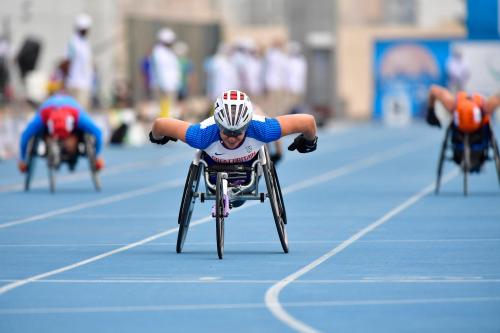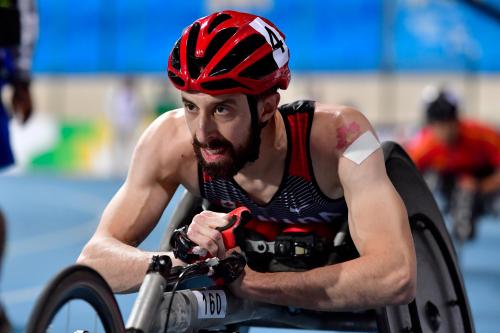 Hannah Cockcroft, photo and copyright by IPC
Hannah Cockcroft, photo and copyright by IPC
Stuart Weir wants you, kind reader, to understand the vagaries of the IPC 100 meters (metres).
 Brent Lakatos, photo and copyright by IPC
Brent Lakatos, photo and copyright by IPC
All you wanted to know about the 100 metres and were afraid to ask.
The 100 metres is often the highlight of a track and field meet. It is over quickest and the winner takes the title of the fastest man or woman in the world, the country, the county etc. Who is the fastest human? In IAAF circles, based on the Doha 2019 World Championships, the question is easy to answer: Christian Coleman and Shelly-Ann Fraser-Pryce, winners of the 100m. But the process is more complicated in the IPC World Championships as there are 32 different 100 metres races in 17 different classifications for men and 15 for women. For the record there is no T33 (cerebral palsy) and no T51 (wheelchair) 100m for women, officially because there are not enough elite women in these classifications to make the events competitive. 32 seems a lot but as Chairman of London 2017, Ed Warner, said – 100 metres races are exciting and whatever session you come you have a good chance of seeing one!
Having thirty-two separate 100 metres races certainly makes for a long programme and arguably cheapens a gold medal when an event goes straight to a final as there are not enough competitors to require heats or semi-finals. But it is the only way to place athletes in a fair competition where everyone has a chance. There is even an argument that there are not enough categories to guarantee that level playing field.
Of course, you can compare times and choose the fastest Para athlete. It tends to be between amputee and visual impairment. I am a little hesitant to pick out the fastest and suggest that they are the best, as all of the winners have done incredibly well and their time is in relation to their disability. The following two tables show the list of 2019 100m world champions by classification and then by finishing time. The fastest para athletes are Petrucio Ferreira dos Santos and Omara Durand – one with visual impairment and one amputee to show again that neither category is entirely dominant.
MEN | ||||
Class | Description | Name | Country | Time |
T11 | Visual impairment | Lucas Prado | BRA | 10.95 |
T12 | Visual impairment | Salum Kashafli | NOR | 10.54 |
T13 | Visual impairment | Jason Smyth | IRE | 10.54 |
T33 | Athetosis etc wheelchair | Ahmad Almutairi | KUW | 17.08 |
T34 | Athetosis etc wheelchair | Walid Ktila | ||
T35 | Cerebral palsy etc | |||
T36 | Cerebral palsy etc | |||
T37 | Cerebral palsy etc | RUS | 11.18 | |
T38 | Cerebral palsy etc | Dening Zhu | CHN | 11.00 |
T47 | Arm Amputee | Petrucio Ferreira dos Santos | BRA | 10.44 |
T51 | Wheelchair | Toni Piispanen | FIN | 20.33 |
T52 | Wheelchair | Raymond Martin | USA | 16.88 |
T53 | Wheelchair | Brent Lakatos | CAN | 14.59 |
T54 | Wheelchair | 13.97 | ||
T63 | Amputee | Daniel Wagner | DEN | 12.32 |
T64 | Amputee | Johannes Floors | GER | 10.60 |
RR3 | Use Tricycle without pedals | 16.72 | ||
WOMEN | ||||
Class | Description | Name | Country | Time |
T11 | Visual impairment | Jerusa Geber dos Santos | BRA | |
T12 | Visual impairment | Omara Durand | CUB | 11.66 |
T13 | Visual impairment | Leilia Adzhametova | UKR | 12.19 |
T34 | Athetosis etc wheelchair | Hannah Cockroft | GBR | 16.77 |
T35 | Athetosis etc wheelchair | Maria Lyle | GBR | 14.62 |
T36 | Cerebral palsy etc | 13.62 | ||
T37 | Cerebral palsy etc | Xiaoyan Wen | CHN | 13.2 |
T38 | Cerebral palsy etc | Sophie Hahn | GBR | 12.38 |
T47 | Arm Amputee | Brittni Mason | USA | 11.89 |
T53 | Wheelchair | Fang Gao | CHN | 16.26 |
T54 | Wheelchair | Amanda Kotaja | FIN | 16.00 |
T63 | Amputee | Karisma Tiarani | INA | 14.72 |
T64 | Amputee | Irmgard Bensusan | USA | 12.86 |
RR3 | Use Tricycle without pedals | Hayleigh Haggo | GBR | 18.32 |
In the table above, by noting that the lower the number, the greater the disability within a category, you can see the progression within cerebral palsy, visual impairment and wheelchair – but there are exceptions as there are in some classes simply better athletes than in others.
Class | Gender | Description | Name | Country | Time |
T47 | Men | Arm Amputee | Petrucio Ferreira dos Santos | BRA | 10.44 |
T12 | Men | Visual impairment | Salum Kashafli | NOR | 10.54 |
T13 | Men | Visual impairment | Jason Smyth | IRE | 10.54 |
T64 | Men | Amputee | Johannes Floors | GER | 10.60 |
T11 | Men | Visual impairment | Lucas Prado | BRA | 10.95 |
T38 | Men | Cerebral palsy etc | Dening Zhu | CHN | 11.00 |
T37 | Men | Cerebral palsy etc | RUS | 11.18 | |
T12 | Women | Visual impairment | Omara Durand | CUB | 11.66 |
T36 | Men | Cerebral palsy etc | |||
T11 | Women | Visual impairment | Jerusa Geber dos Santos | BRA | |
T47 | Women | Arm Amputee | Brittni Mason | USA | 11.89 |
T35 | Men | Cerebral palsy etc | |||
T13 | Women | Visual impairment | Leilia Adzhametova | UKR | 12.19 |
T63 | Men | Amputee | Daniel Wagner | DEN | 12.32 |
T38 | Women | Cerebral palsy etc | Sophie Hahn | GBR | 12.38 |
T64 | Women | Amputee | Irmgard Bensusan | USA | 12.86 |
T37 | Women | Cerebral palsy etc | Xiaoyan Wen | CHN | 13.20 |
T36 | Women | Cerebral palsy etc | 13.62 | ||
T54 | Men | Wheelchair | 13.97 | ||
T53 | Men | Wheelchair | Brent Lakatos | CAN | 14.59 |
T35 | Women | Athetosis etc wheelchair | Maria Lyle | GBR | 14.62 |
T63 | Women | Amputee | Karisma Tiarani | INA | 14.72 |
T34 | Men | Athetosis etc wheelchair | Walid Ktila | ||
T54 | Women | Wheelchair | Amanda Kotaja | FIN | 16.00 |
T53 | Women | Wheelchair | Fang Gao | CHN | 16.26 |
RR3 | Men | Use Tricycle without pedals | 16.72 | ||
T34 | Women | Athetosis etc wheelchair | Hannah Cockroft | GBR | 16.77 |
T52 | Men | Wheelchair | Raymond Martin | USA | 16.88 |
T33 | Men | Athetosis etc wheelchair | Ahmad Almutairi | KUW | 17.08 |
RR3 | Women | Use Tricycle without pedals | Hayleigh Haggo | GBR | 18.32 |
T51 | Men | Wheelchair | Toni Piispanen | FIN | 20.33 |
It is no surprise that the six fastest are men but interesting beyond that how the list almost alternates between men and women. The top ten or so times are highly respectable times even for athletes without a disability.





















